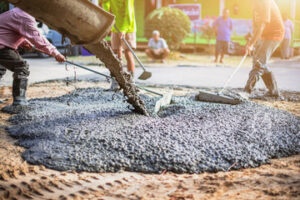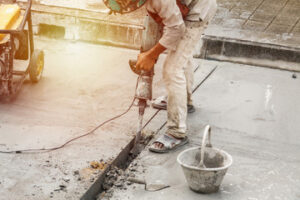Paving your driveway is a big project that requires special skills and heavy equipment. It also needs to be done correctly for it to last.
Asphalt is a good option for homeowners who want a low-maintenance, long-lasting driveway surface. Cracks in an asphalt driveway are easier to repair than gravel ones. Contact Driveway Paving Charleston SC now!

The cost of paving your driveway depends on the material and size. You can choose from a variety of options, including gravel, asphalt, and concrete. Gravel is the cheapest option, while pavers and concrete are more expensive. You can also save money by choosing a standard shape, such as square or rectangle. In addition, if your driveway requires extensive preparation or drainage solutions, you’ll pay more.
The first step in the paving process is laying the base layer. This can be done by either removing the existing driveway and putting down new soil or putting down an aggregate layer that can be compacted with a roller. This layer provides stability and resistance to freezing temperatures. It also helps prevent water damage to the surface.
Once the base layer is in place, your contractor will add the asphalt top. This is rolled out with a proof roller to ensure it is smooth. The asphalt top should be sealed to protect the surface and extend its lifespan. You should inspect your paved driveway regularly and repair any cracks as soon as you notice them.
Paving your driveway can increase the curb appeal of your home and improve its value. However, it is important to consider the costs before you hire a contractor. It’s also important to compare prices between contractors before making a decision. In addition, if you’re planning to sell your house in the future, a well-maintained driveway can help you get a higher asking price.
Driveway paving can be a costly project, but it can significantly improve the appearance of your home. If your old driveway has potholes and large cracks, a paved one can make the property look more appealing to potential buyers. In addition, a paved driveway can be more durable and less expensive to maintain than an unpaved one. If you’re unsure of how much to spend on a paving project, consult with local paving pros for an estimate. They can advise you on the best materials and installation methods to suit your budget. They may also provide advice on additional projects, such as lighting and the best driveway alarms.
Durability
When a homeowner decides to invest in Driveway Paving, they want a surface that will withstand heavy traffic loads, last for years and look great. Choosing pavers made of concrete, cobblestone, brick or asphalt is an excellent choice as these materials have lengthy lifespans and require minimal maintenance. They also resist weathering and will not crack or crumble, ensuring that your driveway looks beautiful year after year.
Paving a driveway creates an attractive first impression for visitors and makes the area easier to navigate than a gravel or dirt surface. This makes a paved driveway a great investment that will add value to your home and increase its curb appeal. In addition, a paved driveway is less likely to sustain damage from a snowplow or other vehicles. It is important to have your driveway properly graded and well-drainaged, however, as improper grading can lead to hazardous pooling of rainwater that causes rapid degradation.
A paved driveway is also easy to clean and minimizes dust, mud or erosion issues. Its smooth surface also prevents weed growth and eliminates the need for regular resurfacing, saving homeowners money in the long run. In contrast, a gravel or dirt driveway requires regular resurfacing and sanding to maintain its integrity.
The durability of a paved driveway depends on several factors, including the type of pavement material and installation method. The most common paving material for residential driveways is asphalt. Although it may not be as durable as concrete, it is cost-effective and can last up to 40 years with proper maintenance. Asphalt is also resistant to freeze-thaw cycles and de-icing salts, making it a durable choice for homes in climates with extreme temperatures.
In contrast, paver stones are more difficult to damage than poured concrete or asphalt. Their modular design allows them to be replaced individually, reducing repair costs and preventing unsightly patch jobs. In addition, pavers are non-absorbent and able to withstand the freeze-thaw cycle without cracking or discoloring. Unlike asphalt, paver driveways are also resistant to weathering and will not fade.
Maintenance
A well-paved driveway improves your home’s curb appeal and offers a convenient location to park vehicles. However, it requires regular maintenance and repairs to prevent damage and preserve its appearance. Cracks, potholes, and uneven surfaces can damage vehicles and pose tripping hazards for pedestrians. Regular inspections help identify problems and facilitate timely repair, extending the lifespan of your driveway.
The most common problems with driveways are cracking, puddle formation, surface depression, and drainage issues. Moisture degrades pavement more quickly than any other natural factor. Water seeping into cracks erodes the base layer, causing the surface to collapse or sink into potholes.
Driveway paving materials require different levels of maintenance, but all of them need to be protected from moisture and UV damage. Concrete and asphalt driveways need to be resealed every few years to keep water out and extend their lifespan. During the resealing process, a skilled contractor will fill any visible cracks and repair hairline cracks to prevent them from worsening.
Asphalt driveways also need to be maintained by regularly cleaning the surface. This includes removing leaves, branches, and other debris that may become trapped in the surface. It is also important to clean up oil, gasoline, and chemical spills promptly. Chemicals can break down the binder in asphalt, causing it to deteriorate.
Proper maintenance also includes maintaining a proper surface grade to promote proper drainage. A properly graded driveway allows water to flow away from the center and toward the edges of the driveway. In addition, it is important to regularly clean gutters and downspouts to ensure that they are not clogged, which can lead to flooding or erosion.
Uneven surfaces and cracks can cause tripping hazards for pedestrians, which can be dangerous for children or elderly people. In addition, they can also damage vehicles and tires. Performing routine maintenance and inspections can prevent these problems from occurring, saving you time and money in the long run.
Appearance
The appearance of your driveway is an important part of the overall look of your home. Having a well-laid asphalt driveway with an attractive design can improve the curb appeal of your home and make it more appealing to potential buyers. It also helps maintain your property value. Whether you are looking for a traditional, modern, or rustic style, the right asphalt driveway paving can help achieve your desired look and match your home’s architecture.
Proper planning is crucial to the success of any paving project, including driveways. It is recommended to work with a professional that can guide you through the process. They will be able to assess your needs and recommend the best solution for your driveway based on its shape, drainage, and the amount of traffic it will support. They will also discuss the costs and time required to complete the project.
There are many different types of asphalt paving materials and designs to choose from. A standard black surface is a popular choice because it provides excellent traction and can be easily maintained. However, you can also customize the look with unique color variations or even stamped designs. Adding a decorative stone edging is another great way to enhance the look of your asphalt driveway.
In addition to aesthetics, the paving material you choose should also be low-maintenance. It should not crack or shift under heavy vehicles, and should be able to withstand harsh weather conditions. Additionally, the paving should have proper slope to prevent water from pooling on the surface. Insufficient slope can lead to faster deterioration of the driveway, and may result in costly repairs.
If your asphalt driveway is in need of repair, you should notice puddles or areas where the pavement appears soft or spongy. This is a sign of poor compaction and should be addressed immediately.
A paved driveway that has clearly defined edges will not only look good, but it will also provide additional protection for the surface against weeds and erosion. This is especially important in areas that receive a lot of rainfall, as the edges will prevent water from seeping into the asphalt and weakening it over time. If your paved driveway has soft areas, you should schedule an appointment with a contractor to inspect the subgrade and make necessary repairs.


